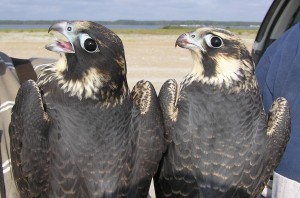 We began a collaboration in December 2022 with Arnaud Van Wettere (DVM, MS, PhD, DACVP)
We began a collaboration in December 2022 with Arnaud Van Wettere (DVM, MS, PhD, DACVP)
at the School of Veterinary Medicine, Utah State University. Entitled Prevalence of Avian Influenza A Virus Antibodies in Migrating North American Peregrine Falcons, it is summarized thus:
An outbreak of highly pathogenic avian influenza (HPAI) virus H5N1 started in the fall of 2021. The scale of this outbreak is unprecedented; it is the largest and most prolonged to date in the USA. Raptors are known to be particularly susceptible to HPAI, with most succumbing within a few days post infection. Given that Peregrine Falcons often prey on bird species known to carry the virus asymptomatically (e.g., waterfowl, gulls, shorebirds), they are at a higher risk of exposure to the virus than most raptor species. While a small number of wild Peregrine Falcons and falconry birds that succumbed to HPAI virus infection have been found during this outbreak, data on how many falcons survive infection is lacking. Studies during past outbreaks have shown that very few falcons (<0.1%) have antibodies to avian influenza virus. However, past HPAI outbreaks occurred in the fall and/or winter and disappeared in early summer with the return of warm temperatures. Therefore, exposure to the virus of Peregrine Falcons that migrate to Central and South America for the winter was likely limited. As this outbreak started in the fall of 2021 but persisted during the summer and fall 2022, Peregrine Falcons are more likely to have been exposed to HPAI virus than in past outbreaks. The goal of this study is to detect evidence of exposure to avian influenza virus. The presence of antibodies to avian influenza virus will be evaluated in the plasma of Peregrine Falcons captured during the fall and spring of 2021-2022 and the spring of 2023 to determine how many Peregrine Falcons have developed an immune response against the virus. Determining the prevalence of antibodies against avian influenza virus will provide documentation of exposure to the virus in migrant Peregrine Falcons and indicate whether some falcons survived infection.
We have tested 571 peregrine samples, with 6 birds positive for influenza A antibodies. For spring and fall 2021 (the period before the HPAI outbreak began) the combined number of positives is one out of 236 birds (0.42%, similar to past studies). For the outbreak period of Spring 2022 (0/26), Fall 2022 (4/107, 0/45), Spring 2023 (1/25), Fall 2023 (0/96, 0/36) the combined number of positive birds is 4/335 (1.19%). A single individual sampled during different migrations accounted for two of the positives, so was removed from the 2022-23 results. This is of keen interest in relation to immunity persistence among peregrines. The number of birds with antibodies remains very low, but perhaps higher than reported in past Surveys. The percentage of peregrines with antibodies in past studies in the US was 1/472 (0.2%) in 2006 to 2010, and 2/299 (0.67%) in 2001 to 2004, and 2 of 109 falcons (1.83%) during the large outbreak of 2014 to 2015. The encouraging news is that AI exposure is not invariably fatal to peregrines, although most succumb rapidly. We also infer that serology metrics in peregrines do relate to the scale of outbreaks, which has grown considerably. We look forward to the 2024 serology information gathered and screening results.
